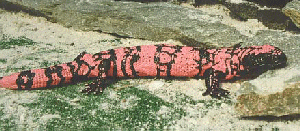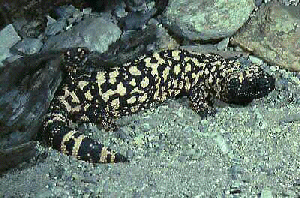![[Picture of Gila monster]](gilamnstr10.gif)
![[Picture of Gila monster]](gilamnstr10.gif)

GILA MONSTER SCIENTIFIC CLASSIFICATION
| KINGDOM | Animalia |
| PHYLUM | Chordata |
| CLASS | Reptilia |
| ORDER | Squamata |
| SUBORDER | Lacertilia |
| FAMILY | Helodermatidae |
| GENUS/SPECIES | COMMON NAME |
| Heloderma suspectum suspectum | Reticulated(Southern)gila monster |
| Heloderma suspectum cinctum | Banded(Northern)gila monster |








Music From: I Will Survive




This page hosted by ![]() Get your own Free Home Page
Get your own Free Home Page
